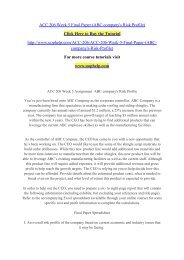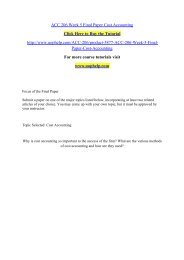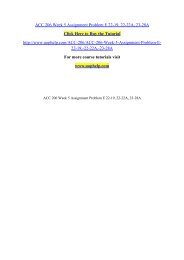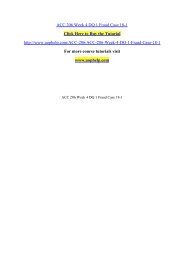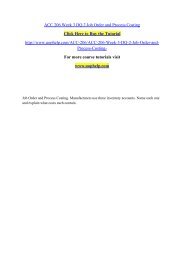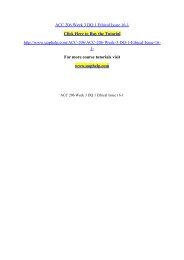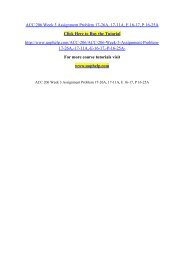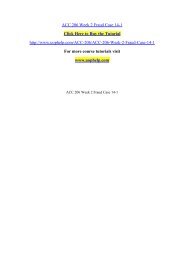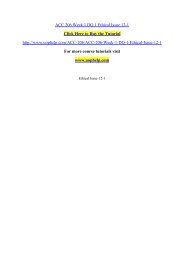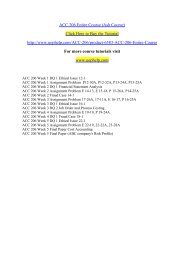ACC 205 Week 5 Exercise Assignment Financial Ratios/ UOPHELP
For more course tutorials visit www.uophelp.com 1. 1. Liquidity ratios. Edison, Stagg, and Thornton have the following financial information at the close of business on July 10: Edison Stagg Thornton Cash $4,000 $2,500 $1,000 Short-term investments 3,000 2,500 2,000 Accounts receivable 2,000 2,500 3,000 Inventory 1,000 2,500 4,000 Prepaid expenses 800 800 800 Accounts payable 200 200 200 Notes payable: short-term 3,100 3,100 3,100 Accrued payables 300 300 300 Long-term liabilities 3,800 3,800 3,800
For more course tutorials visit
www.uophelp.com
1. 1. Liquidity ratios. Edison, Stagg, and Thornton have the following financial information at the close of business on July 10:
Edison Stagg Thornton
Cash $4,000 $2,500 $1,000
Short-term investments 3,000 2,500 2,000
Accounts receivable 2,000 2,500 3,000
Inventory 1,000 2,500 4,000
Prepaid expenses 800 800 800
Accounts payable 200 200 200
Notes payable: short-term 3,100 3,100 3,100
Accrued payables 300 300 300
Long-term liabilities 3,800 3,800 3,800
Create successful ePaper yourself
Turn your PDF publications into a flip-book with our unique Google optimized e-Paper software.
<strong>ACC</strong> <strong>205</strong> <strong>Week</strong> 5 <strong>Exercise</strong> <strong>Assignment</strong> <strong>Financial</strong> <strong>Ratios</strong> (New)<br />
Click Here To Buy The Tutorial<br />
http://www.uophelp.com/<strong>ACC</strong>-<strong>205</strong>-(New)/product-10169-<strong>ACC</strong>-<strong>205</strong>-<strong>Week</strong>-5-<br />
<strong>Exercise</strong>-<strong>Assignment</strong>-<strong>Financial</strong>-<strong>Ratios</strong>-(New)<br />
For more course tutorials visit<br />
www.uophelp.com<br />
1. 1. Liquidity ratios. Edison, Stagg, and Thornton have the following financial<br />
information at the close of business on July 10:<br />
Edison Stagg Thornton<br />
Cash $4,000 $2,500 $1,000<br />
Short-term investments 3,000 2,500 2,000<br />
Accounts receivable 2,000 2,500 3,000<br />
Inventory 1,000 2,500 4,000<br />
Prepaid expenses 800 800 800<br />
Accounts payable 200 200 200<br />
Notes payable: short-term 3,100 3,100 3,100<br />
Accrued payables 300 300 300<br />
Long-term liabilities 3,800 3,800 3,800<br />
1. Compute the current and quick ratios for each of the three companies. (Round<br />
calculations to two decimal places.) Which firm is the most liquid? Why?<br />
2. Suppose Thornton is using FIFO for inventory valuation and Edison is using LIFO.<br />
Comment on the comparability of information between these two companies.<br />
3. If all short-term notes payable are due on July 11 at 8 a.m., comment on each<br />
company's ability to settle its obligation in a timely manner.<br />
1. 2. Computation and evaluation of activity ratios. The following data relate to<br />
Alaska Products, Inc:<br />
19X5 19X4<br />
Net credit sales $832,000 $760,000<br />
Cost of goods sold 440,000 350,000
Cash, Dec. 31 125,000 110,000<br />
Accounts receivable, Dec. 31 180,000 140,000<br />
Inventory, Dec. 31 70,000 50,000<br />
Accounts payable, Dec. 31 115,000 108,000<br />
The company is planning to borrow $300,000 via a 90-day bank loan to cover short-term<br />
operating needs.<br />
1. Compute the accounts receivable and inventory turnover ratios for 19X5. Alaska<br />
rounds all calculations to two decimal places.<br />
2. Study the ratios from part (a) and comment on the company's ability to repay a bank<br />
loan in 90 days.<br />
3. Suppose that Alaska's major line of business involves the processing and distribution<br />
of fresh and frozen fish throughout the United States. Do you have any concerns<br />
about the company's inventory turnover ratio? Briefly discuss.<br />
1. 3. Profitability ratios, trading on the equity. Digital Relay has both preferred<br />
and common stock outstanding. The company reported the following information for<br />
19X7:<br />
Net sales $1,500,000<br />
Interest expense 120,000<br />
Income tax expense 80,000<br />
Preferred dividends 25,000<br />
Net income 130,000<br />
Average assets 1,100,000<br />
Average common stockholders' equity 400,000<br />
1. Compute the profit margin on sales and the rates of return on assets and common<br />
stockholders' equity, rounding calculations to two decimal places.<br />
2. Does the firm have positive or negative financial leverage? Briefly explain.<br />
1. 4. <strong>Financial</strong> statement construction via ratios. Incomplete financial statements<br />
of Lock Box, Inc., are presented below.<br />
LOCK BOX, INC.<br />
Income Statement<br />
For the Year Ended December 31, 19X3<br />
Sales $ ?<br />
Cost of goods sold ?
Gross profit $15,000,000<br />
Operating expenses & interest ?<br />
Income before tax $ ?<br />
Income taxes, 40% ?<br />
Net income $ ?<br />
LOCK BOX, INC.<br />
Balance Sheet<br />
December 31, 19X3<br />
Assets<br />
Cash<br />
Accounts receivable<br />
Inventory<br />
Property, plant, &. equipment<br />
Total assets<br />
Liabilities & Stockholders' Equity<br />
Accounts payable<br />
Notes payable (short-term)<br />
Bonds payable<br />
Common stock<br />
Retained earnings<br />
Total liabilities & stockholders' equity<br />
$ ?<br />
?<br />
?<br />
8,000,000<br />
$24,000,000<br />
$ ?<br />
600,000 4,600,000<br />
2,000,000<br />
?<br />
$24,000,000<br />
Further information:<br />
1. Cost of goods sold is 60% of sales. All sales are on account.<br />
2. The company's beginning inventory is $5 million; inventory turnover is 4.<br />
3. The debt to total assets ratio is 70%.<br />
4. The profit margin on sales is 6%.<br />
5. The firm's accounts receivable turnover is 5. Receivables increased by $400,000<br />
during the year.<br />
Instructions:<br />
Using the preceding data, complete the income statement and the balance sheet.



